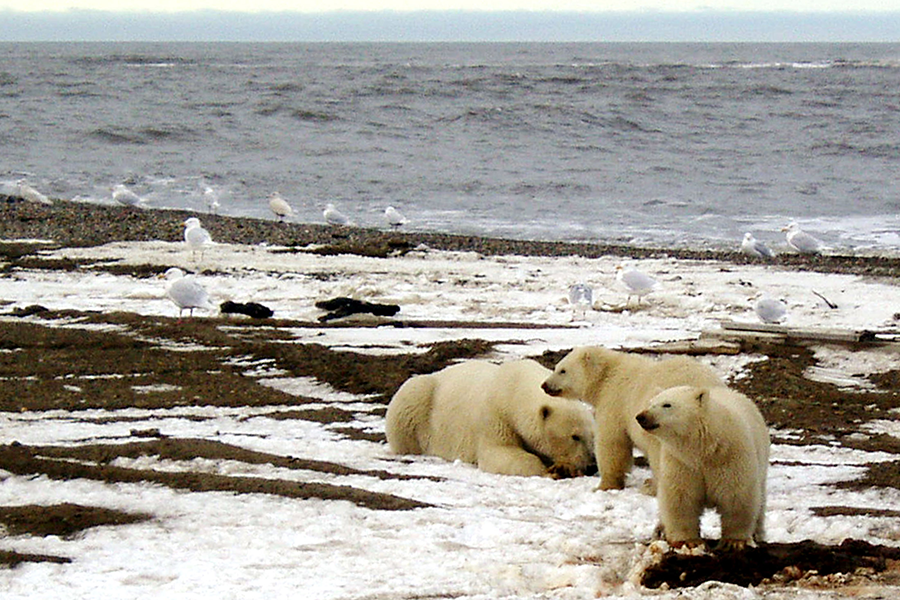16-foot waves in the Arctic: a harbinger of ice-free summers?
Loading...
Triggered by a powerful September storm, waves the height of a diesel locomotive rolled through the Arctic Ocean's central Beaufort Sea in September 2012, an event scientists have captured in the first study of waves and swells in that region.
In any other ocean, 16-foot seas would hardly be novel. In this region of the Arctic Ocean, however, which until recently was ice-covered throughout the summer, they are new and largely unwelcome.
The study shows how the waves morphed into swells – undulations whose rise and fall can break up ice deep into the interior of large ice floes and in only a few hours. This action is expected to hasten the long-term retreat of summer sea ice, already underway due to climate change. When the swells reach the coast to break as waves, they increase erosion. And intense wave action can bring deeper, warmer water to the surface, where it can melt ice and provide energy and moisture for storms.
The shrinking extent of summer sea ice increases the expanse of open water, or fetch, available to waves and swells to traverse and build.
In that sense, "it's a pretty simple prediction that the additional open water should make waves," said Jim Thomson, an oceanographer with the University of Washington's Applied Physics Laboratory in Seattle and the lead author of the paper reporting the results. And 2012 was the perfect year to hunt for the effect.
That year, the extent of summer sea ice reached a record low, based on satellite measurements made since 1979. This exposed a wide expanse of the Arctic Ocean, including the Beaufort Sea, to the atmosphere. A powerful storm in August 2012 and the wave action it generated has been tagged as one of the key drivers behind the record loss.
Shortly after the storm, Dr. Thomson and colleague Erick Rogers, an oceanographer with the US Naval Research Laboratory's field office at NASA's Stennis Space Center in Mississippi, began gathering data from an undersea sensor fixed to a mooring 300 miles northeast of Barrow, Alaska. The sensor, some 160 feet below the surface, used rapid-fire sonar pings to measure the distance to the surface, which varied with wave action.
The team combined the results with satellite images and computer simulations with a wave model the US Navy had developed.
Modeling the August storm, the duo found that wave heights were somewhat lower than those for the September storm for which they had measurements. At the time, there wouldn't have been as much open ocean for the waves to traverse as there was a month later, when the sea ice reached its minimum extent for the year.
The team recorded wave heights of up to 16 feet, driven by winds that topped 40 miles an hour. The storm's duration and the long fetch allow the swells to form.
Swells are particularly nasty from the ice's point of view because they carry more energy that local wind-driven waves and take longer to dissipate when they encounter ice, the researchers explain.
The results, published in May in the journal Geophysical Research Letters, come at a time of heightened interest in pinning down the details of ice-wave interactions, as well as other factors contributing to what polar scientists say could be largely ice-free summers in the next 30 to 40 years.
Countries that border on the Arctic Ocean already are staking claims to undersea areas they could exploit for oil and gas, minerals, and fishing – activities that, for the region, might have seemed pipe dreams only a few decades ago. In addition, the open waters promise shorter ocean shipping routes between Eurasia and Asia through ecologically sensitive passages.
An international team of scientists currently is gathering data as part of a five-year research program to better understand the processes – including wave and swell action – affecting the so-called marginal ice zone. The zone is a region at the edge of pack ice where waves and swells can penetrate to break up ice. In some cases, this zone can extend up to 150 miles into the interior of pack ice. It's the zone that poses the largest threat to maritime activity in the region.
The goal of the Marginal Ice Zone Program, currently focusing on the Beaufort Sea and Canadian Basin, where the melt-season losses have been the fastest and largest, is to translate what the team learns into tools that will allow forecasters to predict ice behavior on a range of time scales.





